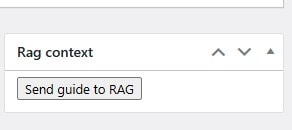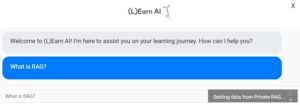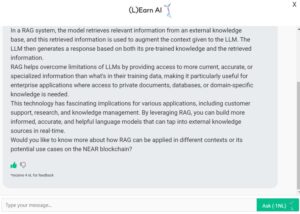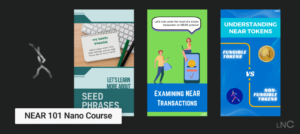What is an AI agent?
An AI agent is an autonomous software entity designed to perform tasks by perceiving its environment, processing information, and taking actions to achieve specific goals. An AI agent typically comprises three core components:
- Intelligence: The large language model (LLM) that drives the agent’s cognitive capabilities, enabling it to understand and generate human-like text. This component is usually guided by a system prompt that defines the agent’s goals and the constraints it must follow.
- Knowledge: The domain-specific expertise and data that the agent leverages to make informed decisions and take action. Agents utilize this knowledge base as context, drawing on past experiences and relevant data to guide their choices.
- Tools: A suite of specialized tools that extend the agent’s abilities, allowing it to efficiently handle a variety of tasks. These tools can include API calls, executable code, or other services that enable the agent to complete its assigned tasks.
What are the three core components of an AI agent?
What is RAG?
Retrieval-Augmented Generation (RAG) is an AI technique that enhances large language models (LLMs) by integrating relevant information from external knowledge bases. Through semantic similarity calculations, RAG retrieves document chunks from a vector database, where these documents are stored as vector representations. This process reduces the generation of factually incorrect content, significantly improving the reliability of LLM outputs.\cite{RAG}
A RAG system consists of two core components: the vector database and the retriever. The vector database holds document chunks in vector form, while the retriever calculates semantic similarity between these chunks and user queries. The more similar a chunk is to the query, the more relevant it is considered, and it is then included as context for the LLM. This setup allows RAG to dynamically update an LLM’s knowledge base without the need for retraining, effectively addressing knowledge gaps in the model’s training data.
The RAG pipeline operates by augmenting a user’s prompt with the most relevant retrieved text. The retriever fetches the necessary information from the vector database and injects it into the prompt, providing the LLM with additional context. This process not only enhances the accuracy and relevance of responses but also makes RAG a crucial technology in enabling AI agents to work with real-time data, making them more adaptable and effective in practical applications.
How does Retrieval-Augmented Generation (RAG) improve LLM responses?
What is Agent Memory?
AI agents, by default, are designed to remember only the current workflow, with their memory typically constrained by a maximum token limit. This means they can retain context temporarily within a session, but once the session ends or the token limit is reached, the context is lost. Achieving long-term memory across workflows—and sometimes even across different users or organizations—requires a more sophisticated approach. This involves explicitly committing important information to memory and retrieving it when needed.
Agent Memory with blockchain:
XTrace – A Secure AI Agent Knowledge & Memory Protocol for Collective Intelligence – will leverage blockchain as the permission and integrity layer for agent memory, ensuring that only the agent’s owner has access to stored knowledge. Blockchain is especially useful for this long persistent storage as XTrace provides commitment proof for the integrity of both the data layer and integrity of the retrieval process. The agent memory will be securely stored within XTrace’s privacy-preserving RAG framework, enabling privacy, portability and sharability. This approach provides several key use cases:
Stateful Decentralized Autonomous Agents:
- XTrace can act as a reliable data availability layer for autonomous agents operating within Trusted Execution Environments (TEEs). Even if a TEE instance goes offline or if users want to transfer knowledge acquired by the agents, they can seamlessly spawn new agents with the stored network, ensuring continuity and operational resilience.
XTrace Agent Collaborative Network:
- XTrace enables AI agents to access and inherit knowledge from other agents within the network, fostering seamless collaboration and eliminating redundant processing. This shared memory system allows agents to collectively improve decision-making and problem-solving capabilities without compromising data ownership or privacy.
XTrace Agent Sandbox Test:
- XTrace provides a secure sandbox environment for AI agent developers to safely test and deploy their agents. This sandbox acts as a honeypot to detect and mitigate prompt injection attacks before agents are deployed in real-world applications. Users can define AI guardrails within XTrace, such as restricting agents from mentioning competitor names, discussing political topics, or leaking sensitive key phrases. These guardrails can be enforced through smart contracts, allowing external parties to challenge the agents with potentially malicious prompts. If a prompt successfully bypasses the defined safeguards, the smart contract can trigger a bounty release, incentivizing adversarial testing. Unlike conventional approaches, XTrace agents retain memory of past attack attempts, enabling them to autonomously learn and adapt to new threats over time. Following the sandbox testing phase, agents carry forward a comprehensive memory of detected malicious prompts, enhancing their resilience against similar attacks in future deployments.
How to create a Personalized AI agent?
To create an AI agent with XTrace, there are three main steps to follow:
- Define the Purpose: Determine the specific tasks and goals the agent will accomplish.
- Choose the AI Model: Select a suitable LLM or other machine learning models that align with the agent’s requirements.
- Gather and Structure Knowledge: Collect domain-specific data and organize it in a way that the agent can efficiently use.
- Develop Tools and Integrations: Incorporate APIs, databases, or other services that the agent may need to interact with.
How to create a Private Personalized AI agent with XTrace?
XTrace can serve as the data connection layer between the user and the AI agents. Users will be able to securely share data from various apps into the system to create an AI agent that is aware of the user’s system. By leveraging XTrace’s encrypted storage and access control mechanisms, AI agents can be personalized without compromising user privacy. Key features include:
- Seamless Data Integration: Aggregating data from multiple sources securely.
- Granular Access Control: Ensuring only authorized AI agents can access specific data.
- Privacy-Preserving Computation: Enabling AI agents to learn from user data without exposing it.
- Automated Insights: Leveraging AI to provide personalized recommendations based on securely stored data.
- User Ownership: Empowering users with full control over their data and how it is used.
How do we use XTrace private RAG for (L)Earn AI🕺?
- We send learning materials in LLM friendly format to LNC RAG at XTrace

- Once (L)Earn AI🕺 gets the question, first it talks to private RAG and retrieve relevant information

- The LLM hosted at NEAR AI infrastructure generates a response based on both its pre-trained knowledge and the retrieved information!

- Learners are encouraged to provide feedback and get 4nLEARNs to improve (L)Earn AI🕺 to work better for NEAR community!
Updated: February 24, 2025





Top comment
The XTrace can serve as the data connection layer, facilitating communication between users and AI agents.
I'm excited to see how XTrace private RAG is being utilized to enhance the (L)Earn AI experience! The idea of sending learning materials in an LLM-friendly format to the RAG and then retrieving relevant information to inform AI responses is genius. I'm curious to know more about the type of feedback learners are encouraged to provide and how that feedback is used to improve the AI. Is there a way to track the progress and effectiveness of the 4nLEARNs system? Additionally, how does the NEAR community plan to expand the capabilities of (L)Earn AI in the future?
This explanation of how XTrace private RAG is used for (L)Earn AI is fascinating! I love how the process involves a seamless collaboration between the LNC RAG, private RAG, and the LLM hosted on NEAR AI infrastructure. The fact that learners can provide feedback and earn 4nLEARNs to improve the AI is a great incentive to encourage community engagement. I'm curious to know more about how the feedback mechanism works and how it impacts the AI's performance over time. Can anyone share more insights on this?
Fascinating! I've always wondered how to create a personalized AI agent that can cater to specific needs. The three main steps outlined in this article provide a clear roadmap for getting started. I'm particularly intrigued by the 'Gather and Structure Knowledge' step, as I imagine it can be a daunting task to collect and organize domain-specific data. How do you ensure the data is accurate and up-to-date? Are there any specific tools or methodologies recommended for this step? Looking forward to hearing more about the process and potential applications of personalized AI agents!
This article has really opened my eyes to the potential of Retrieval-Augmented Generation (RAG) in revolutionizing the field of large language models. I'm particularly intrigued by the ability of RAG to dynamically update an LLM's knowledge base without retraining, effectively addressing knowledge gaps in the training data. This could have significant implications for industries like customer service, where AI agents need to stay up-to-date with rapidly changing information. I'm curious to know more about the limitations of RAG, such as how it handles contradictory or outdated information in the external knowledge bases. Can anyone share some insights on this?
I'm really excited about the potential of XTrace to create personalized AI agents that prioritize user privacy. The granular access control and privacy-preserving computation features are especially appealing, as they ensure that users remain in control of their data while still benefiting from AI-driven insights. I'd love to see more examples of how XTrace can be integrated with various apps to create a seamless experience. For instance, how would XTrace handle data from health and fitness trackers, and what kind of personalized recommendations could be generated from that data? The possibilities are endless, and I'm eager to explore the capabilities of XTrace further.
Fascinating article! I never realized the complexity behind AI agents. The breakdown into intelligence, knowledge, and tools makes it clearer how these entities can perform tasks autonomously. I'm curious, though – how do these agents handle ambiguous or conflicting goals? For instance, if the system prompt is vague or open-ended, how does the AI agent prioritize its actions? Additionally, what measures are in place to ensure the knowledge base remains up-to-date and unbiased? Looking forward to exploring more about the development and implementation of AI agents in real-world applications.
This article highlights the incredible potential of Retrieval-Augmented Generation (RAG) in enhancing the accuracy and reliability of large language models (LLMs). By integrating external knowledge bases, RAG addresses a major limitation of LLMs, which is their tendency to generate factually incorrect content. What I find particularly interesting is the dynamic update capability of RAG, allowing it to fill knowledge gaps in the model's training data without retraining. This feature makes RAG an essential tool for AI agents working with real-time data. However, I'm curious to know more about the scalability and efficiency of RAG systems, especially when dealing with vast amounts of data. How do they ensure the vector database remains up-to-date and optimized for retrieval?
This concept of agent memory really highlights the limitations of current AI capabilities. It's astonishing that even the most advanced AI agents can only retain context temporarily, and once the session ends, it's gone. I wonder, what would be the implications of developing agents with more human-like memory capabilities? Would it lead to more personalized and efficient interactions, or would it create new challenges in data management and security? Additionally, how do we determine what information is 'important' enough to commit to memory? These are crucial questions to consider as we move forward in AI development.
I love how (L)Earn AI is leveraging private RAG to enhance its learning capabilities! The fact that it can retrieve relevant information from XTrace and combine it with its pre-trained knowledge is a game-changer. I'm curious to know more about the feedback mechanism and how the 4nLEARNs system works. How does the feedback from learners impact the AI's performance, and what kind of improvements can we expect to see over time? Also, are there any plans to open up the private RAG to the broader NEAR community, or will it remain exclusive to (L)Earn AI?
This is really exciting! The integration of XTrace's private RAG with (L)Earn AI 🕺 has the potential to revolutionize the way we learn and interact with AI systems. I love that learners are encouraged to provide feedback and earn 4nLEARNs to improve the model. It's a great way to create a sense of community and ownership. My question is, how does the feedback mechanism work? Is it a rating system or a more in-depth feedback loop? Also, are there plans to expand the range of learning materials and topics available through (L)Earn AI?
Fascinating to see how RAG is revolutionizing the potential of large language models! The ability to dynamically update an LLM's knowledge base without retraining is a game-changer, especially when it comes to addressing knowledge gaps in the model's training data. I'm curious to know more about the scalability of RAG systems, particularly in handling massive vector databases and ensuring the retriever's efficiency in calculating semantic similarity. As we move towards integrating RAG into real-world applications, how do we balance the trade-off between response accuracy and contextual relevance with the potential risks of information overload and bias?
Fascinating to see how XTrace is harnessing blockchain to create a secure and transparent AI agent knowledge and memory protocol! The use cases outlined, such as stateful decentralized autonomous agents and collaborative networks, have enormous potential for transforming industries like finance, healthcare, and education. I'm particularly intrigued by the agent sandbox test, which could revolutionize the way we develop and deploy AI agents while minimizing risks. The incorporation of smart contracts and bounty releases for adversarial testing is a brilliant approach to ensuring accountability and continuous improvement. One question that comes to mind, though, is how XTrace plans to balance the need for decentralized agent autonomy with the potential risks of unchecked agent decision-making? Looking forward to seeing how this technology evolves!